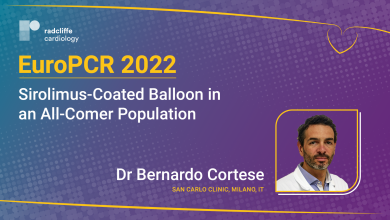Search results
Author(s):
Bernardo Cortese
Added:
1 year ago
Dr Bernardo Cortese (La Fondazione Ricerca e Innovazione Cardiovascolare, IT) discusses the findings from the EASTBOURNE Registry, a study that investigated the sirolimus-coated balloon in an all-comer population.
Findings are positive in regard to the device's safety and efficacy profile, with no safety signals for bleeding and the primary endpoint of target lesion revascularization (TLR), was…
View more
Author(s):
Aleardo Maresta
,
Marco Balducelli
,
Elisabetta Varani
Added:
3 years ago
Cardiovascular disease is a major consequence of diabetes and is associated with peculiar features in this subgroup of patients, representing roughly 25% of the total population treated with percutaneous coronary interventions (PCIs). A consistent proportion of these patients have asymptomatic myocardial ischaemia, which is a more extensive and diffuse atherosclerotic disease with more prevalent…
View more
Author(s):
Bernardo Cortese
Added:
1 year ago
CRT 23 - In this short interview, we are joined by Dr Bernardo Cortese (Fondazione Ricerca e InnovazioneCardiovascolare, IT, DCB Academy, IT,Cardio Parc, FR) to outline the findings from a prespecified sub-analysis of the EASTBOURNE study. In this trial, investigators aimed to evaluate the performance of a sirolimus-coated balloon to treat coronary lesions. This sub-analysis collected and…
View more
Author(s):
Anuj Gupta
,
Issam Moussa
Added:
3 years ago
The treatment of atherosclerotic coronary artery disease (CAD) using percutaneous coronary intervention (PCI) is a well-established procedure that is performed over one million times a year in the US. The Achilles heel of PCI has been the development of neointimal hyperplasia within the stent, resulting in in-stent restenosis (ISR). Sirolimus-eluting stents (SES) provide a platform that in…
View more
Author(s):
Meril Life Sciences
Added:
3 years ago
The first-generation drug-eluting stents (DES) initially demonstrated good promise in terms of reducing the degree of restenosis. They succeeded in arresting the neo-intimal proliferation, which was the bane of coronary stents.1 Over a period of time, however, the polymeric degradation by-products failed to bring about an essential component of the healing process: endothelialisation. Failure of…
View more
Author(s):
Albert Schömig
,
Adnan Kastrati
Added:
3 years ago
Drug-eluting stents (DES) have largely resolved the problem of restenosis, which is the major limitation of plain balloon angioplasty and bare-metal stenting.1 While several DES platforms have been evaluated in the setting of randomised studies and used in clinical practice, most of the accumulated evidence is related to sirolimus-eluting stents (SES) and paclitaxel-eluting stents (PES).2 These…
View more
Author(s):
Wan Azman Wan Ahmad
Added:
2 years ago
In this video, Prof Wan Azman Wan Ahmad (University of Malaya Medical Centre, Kuala Lumpur, MY) outlines the 12 month outcomes of a randomised trial designed to compare the use of sirolumus-coated and paclitaxel-coated balloons in the treatment of de novo coronary lesions. Originally presented at the TCT conference in 2021, this study suggests that negative late lumen loss is more frequently…
View more
Author(s):
Bruno Scheller
Added:
2 years ago
In this video, Professor Bruno Scheller (Saarland University, Saarbrücken, DE) sits down to discuss the one-year angiographic outcomes of two parallel randomized trials investigating the effectiveness off sirolimus-coated and paclitaxel-coated DCB's in the treatment of coronary in-stent restenosis. Findings suggest comparable outcomes in both devices.
Discussion points:
1. Importance of this…
View more
Author(s):
Pantelis Diamantouros
,
David Kandzari
Added:
3 years ago
In both randomised trials, compared with bare metal coronary stents, and in observational registries, treatment with drug-eluting stents (DES) has been associated with considerable reductions in angiographic restenosis and the need for repeat coronary revascularisation procedures. Despite these established benefits in selected patient populations, relatively little is known regarding the safety…
View more
Author(s):
Kamal Chitkara
,
Anthony H Gershlick
Added:
3 years ago
First-generation Stents
Since drug-eluting stents (DES) received the CE mark in 2002 and the US Food and Drug Administration (FDA) approved the first DES in 2003, there has been a significant increase in the use of these devices. The advent of DES has revolutionised the field of interventional cardiology by having a major impact on patient care through their efficacy in reducing the need for…
View more














